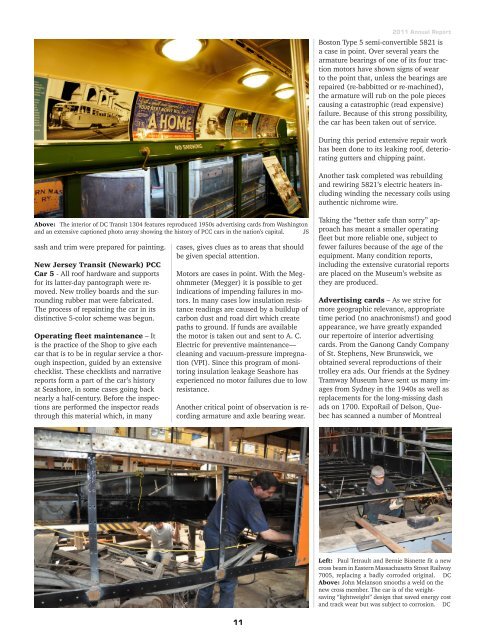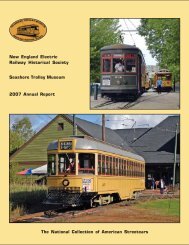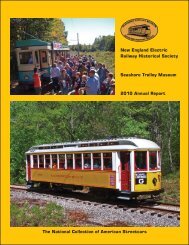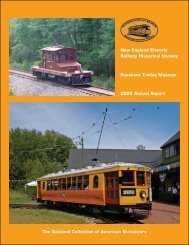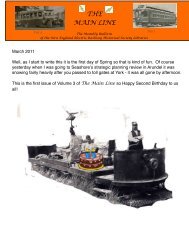2011 Annual Report - the Seashore Trolley Museum
2011 Annual Report - the Seashore Trolley Museum
2011 Annual Report - the Seashore Trolley Museum
Create successful ePaper yourself
Turn your PDF publications into a flip-book with our unique Google optimized e-Paper software.
<strong>2011</strong> <strong>Annual</strong> <strong>Report</strong><br />
Boston Type 5 semi-convertible 5821 is<br />
a case in point. Over several years <strong>the</strong><br />
armature bearings of one of its four traction<br />
motors have shown signs of wear<br />
to <strong>the</strong> point that, unless <strong>the</strong> bearings are<br />
repaired (re-babbitted or re-machined),<br />
<strong>the</strong> armature will rub on <strong>the</strong> pole pieces<br />
causing a catastrophic (read expensive)<br />
failure. Because of this strong possibility,<br />
<strong>the</strong> car has been taken out of service.<br />
During this period extensive repair work<br />
has been done to its leaking roof, deteriorating<br />
gutters and chipping paint.<br />
Ano<strong>the</strong>r task completed was rebuilding<br />
and rewiring 5821’s electric heaters including<br />
winding <strong>the</strong> necessary coils using<br />
au<strong>the</strong>ntic nichrome wire.<br />
Above: The interior of DC Transit 1304 features reproduced 1950s advertising cards from Washington<br />
and an extensive captioned photo array showing <strong>the</strong> history of PCC cars in <strong>the</strong> nation’s capital. JS<br />
sash and trim were prepared for painting.<br />
New Jersey Transit (Newark) PCC<br />
Car 5 - All roof hardware and supports<br />
for its latter-day pantograph were removed.<br />
New trolley boards and <strong>the</strong> surrounding<br />
rubber mat were fabricated.<br />
The process of repainting <strong>the</strong> car in its<br />
distinctive 5-color scheme was begun.<br />
Operating fleet maintenance – It<br />
is <strong>the</strong> practice of <strong>the</strong> Shop to give each<br />
car that is to be in regular service a thorough<br />
inspection, guided by an extensive<br />
checklist. These checklists and narrative<br />
reports form a part of <strong>the</strong> car’s history<br />
at <strong>Seashore</strong>, in some cases going back<br />
nearly a half-century. Before <strong>the</strong> inspections<br />
are performed <strong>the</strong> inspector reads<br />
through this material which, in many<br />
cases, gives clues as to areas that should<br />
be given special attention.<br />
Motors are cases in point. With <strong>the</strong> Megohmmeter<br />
(Megger) it is possible to get<br />
indications of impending failures in motors.<br />
In many cases low insulation resistance<br />
readings are caused by a buildup of<br />
carbon dust and road dirt which create<br />
paths to ground. If funds are available<br />
<strong>the</strong> motor is taken out and sent to A. C.<br />
Electric for preventive maintenance—<br />
cleaning and vacuum-pressure impregnation<br />
(VPI). Since this program of monitoring<br />
insulation leakage <strong>Seashore</strong> has<br />
experienced no motor failures due to low<br />
resistance.<br />
Ano<strong>the</strong>r critical point of observation is recording<br />
armature and axle bearing wear.<br />
Taking <strong>the</strong> “better safe than sorry” approach<br />
has meant a smaller operating<br />
fleet but more reliable one, subject to<br />
fewer failures because of <strong>the</strong> age of <strong>the</strong><br />
equipment. Many condition reports,<br />
including <strong>the</strong> extensive curatorial reports<br />
are placed on <strong>the</strong> <strong>Museum</strong>’s website as<br />
<strong>the</strong>y are produced.<br />
Advertising cards – As we strive for<br />
more geographic relevance, appropriate<br />
time period (no anachronisms!) and good<br />
appearance, we have greatly expanded<br />
our repertoire of interior advertising<br />
cards. From <strong>the</strong> Ganong Candy Company<br />
of St. Stephens, New Brunswick, we<br />
obtained several reproductions of <strong>the</strong>ir<br />
trolley era ads. Our friends at <strong>the</strong> Sydney<br />
Tramway <strong>Museum</strong> have sent us many images<br />
from Sydney in <strong>the</strong> 1940s as well as<br />
replacements for <strong>the</strong> long-missing dash<br />
ads on 1700. ExpoRail of Delson, Quebec<br />
has scanned a number of Montreal<br />
Left: Paul Tetrault and Bernie Bisnette fit a new<br />
cross beam in Eastern Massachusetts Street Railway<br />
7005, replacing a badly corroded original. DC<br />
Above: John Melanson smooths a weld on <strong>the</strong><br />
new cross member. The car is of <strong>the</strong> weightsaving<br />
“lightweight” design that saved energy cost<br />
and track wear but was subject to corrosion. DC<br />
11


